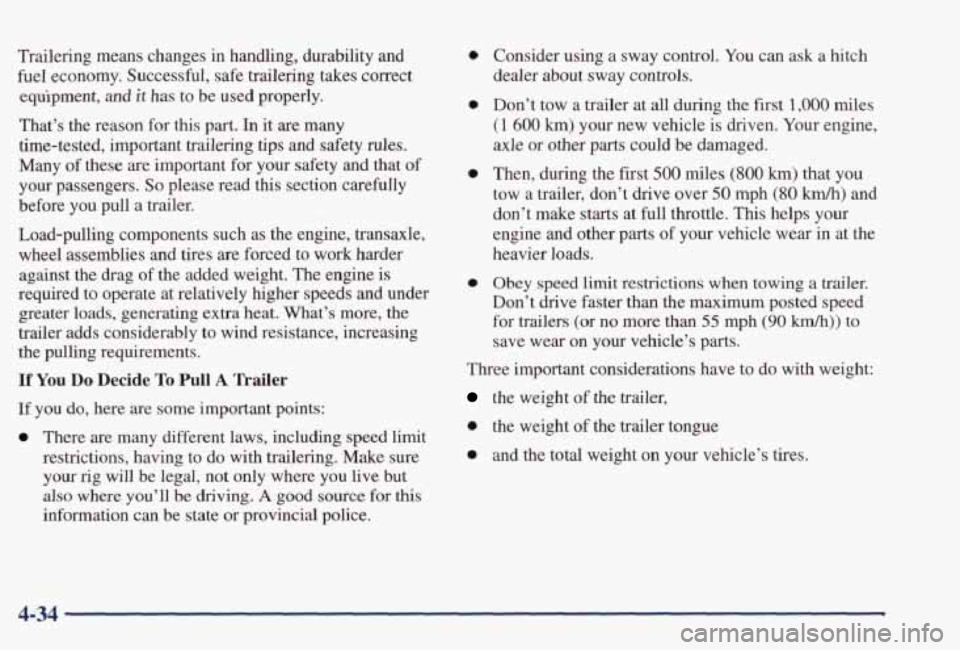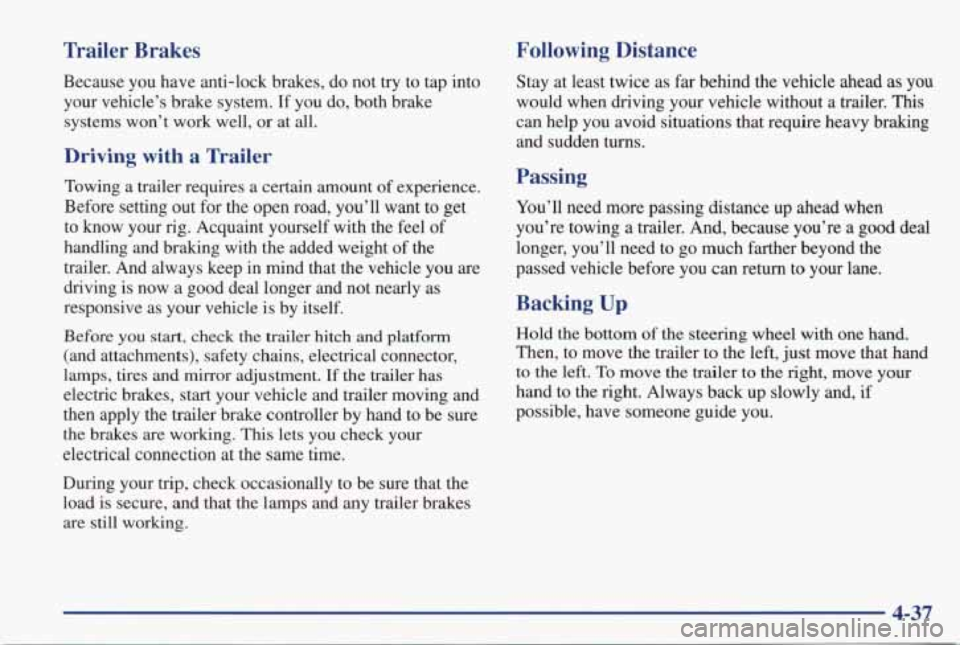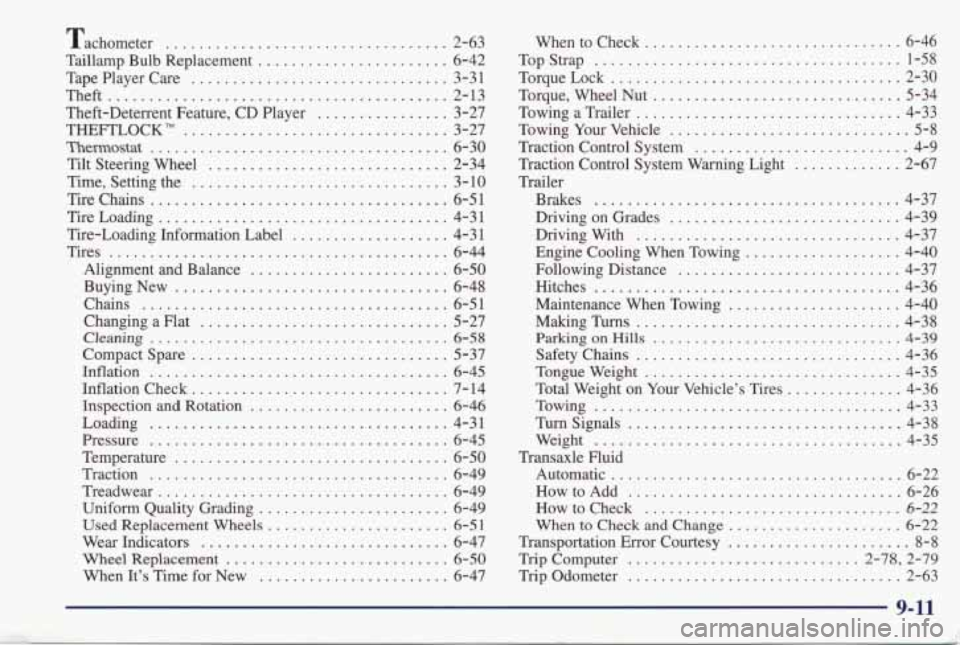1998 PONTIAC GRAND PRIX weight
[x] Cancel search: weightPage 227 of 402

Trailering means changes in handling, durability and
fuel economy. Successful, safe trailering takes correct
equipment,
and it has to be used properly.
That’s the reason for this part.
In it are many
time-tested, important trailering tips and safety rules.
Many
of these are important for your safety and that of
your passengers. So please read this section carefully
before you pull a trailer.
Load-pulling components such as the engine, transaxle,
wheel assemblies and tires are forced to
work harder
against the drag
of the added weight. The engine is
required to operate at relatively higher speeds and under
greater loads, generating extra heat. What’s more,
the
trailer adds considerably to wind resistance, increasing
the pulling requirements.
If You Do Decide To Pull A Trailer
If you do, here are some important points:
0 There are many different laws, including speed limit
restrictions, having to do
with trailering. Make sure
your rig will be legal, not only where you live but
also where you’ll be driving. A good source for this
information can be state or provincial police.
0
0
0
a
Consider using a sway control. You can ask a hitch
dealer about sway controls.
Don’t tow a trailer at
all during the first 1 ,OOO miles
(1
600 km) your new vehicle is driven. Your engine,
axle or other parts could be damaged.
Then, during the first
500 miles (800 km) that you
tow
a trailer, don’t drive over 50 mph (80 km/h) and
don’t make
starts at full throttle. This helps your
engine and other
parts of your vehicle wear in at the
heavier loads.
Obey speed limit restrictions when towing a trailer.
Don’t drive faster
than the maximum posted speed
for trailers
(or no more than 55 mph (90 km/h)) to
save wear on your vehicle’s parts.
Three important considerations have to do with weight:
the weight of the trailer,
0 the weight of the trailer tongue
0 and the total weight on your vehicle’s tires.
4-34
Page 228 of 402

Weight of the Trailer
How heavy can a trailer safely be?
It should never weigh more than
1,000 lbs. But even that
can be too heavy.
It depends on how you plan to use your rig. For
example, speed, altitude, road grades, outside
temperature and how much your vehicle is used to pull a
trailer are
all important. And, it can also depend on any
special equipment that you have on your vehicle.
You can ask your dealer
for our trailering information or
advice, or you can write us at:
Pontiac-GMC Customer Assistance Center
P. 0. Box 436008
Pontiac, MI 48343-6008
In Canada, write to:
General Motors
of Canada Limited
Customer Communication Centre
1908 Colonel
Sam Drive
Oshawa, Ontario L1H 8P7
Weight of the Trailer Tongue
The tongue load (A) of any trailer is an important
weight to measure because it affects the total or
grossweight of your vehicle. The Gross Vehicle Weight
(GVW) includes the curb weight of the vehicle, any cargo
you may carry in it, and the people who will be
riding in the vehicle. And if you will tow a trailer, you
must add the tongue load
to the GVW because your
vehicle will
be carrying that weight, too. See “Loading
Your Vehicle” in the Index for more information about
your vehicle’s maximum load capacity.
A B
If you’re using a weight-carrying hitch, the trailer
tongue
(A) should weigh 10 percent of the total loaded
trailer weight
(B). If you have a weight-distributing
hitch, the trailer tongue
(A) should weigh 12 percent of
the total loaded trailer weight
(B).
4-35
Page 229 of 402

After you’ve loaded your trailer, weigh the trailer and
then the tongue, separately, to see
if the weights are
proper.
If they aren’t, you may be able to get them right
simply by moving some items around in the trailer.
Total Weight on Your Vehicle’s Tires
Be sure your vehicle’s tires are inflated to the upper
limit for cold tires. You’ll find these numbers on the
Tire-Loading Information label, found on the inside
of the
trunk lid, or see “Loading Your Vehicle” in the
Index. Then be sure
you don’t go over the GVW
limit for your vehicle, including the weight of the
trailer tongue.
Hitches
It’s important to have the correct hitch equipment.
Crosswinds, large trucks going by and rough roads are
a few reasons why you’ll need the right hitch. Here are
some rules to follow:
0 Your vehicle may have nonmetallic, composite
bumpers. The bumpers on
your vehicle are not
intended for hitches. Do not attach rental hitches or
other bumper-type hitches to them. Use only a
frame-mounted hitch that does not attach to
the bumper.
Will you have to make any holes in the body of your
vehicle when you install a trailer hitch?
If you do,
then be sure
to seal the holes later when you remove
the hitch. If you don’t seal them, deadly carbon
monoxide
(CO) from your exhaust can get into your
vehicle (see “Carbon Monoxide” in the Index). Dirt
and water can, too.
Safety Chains
You should always attach chains between your vehicle
and your trailer. Cross the safety chains under the tongue
of the trailer
so that the tongue will not drop to the road
if it becomes separated from the hitch. Instructions
about safety chains may
be provided by the hitch
manufacturer or by
the trailer manufacturer. Follow the
manufacturer’s recommendation for attaching safety
chains and do not attach them to the bumper. Always
leave just enough slack
so you can turn with your rig.
And, never allow safety chains to drag on the ground.
4-36
Page 230 of 402

Trailer Brakes Following Distance
Because you have anti-lock brakes, do not try to
tap into
your vehicle’s brake system.
If you do, both brake
systems won’t work well,
or at all.
Driving with a Trailer
Towing a trailer requires a certain amount of experience.
Before setting
out for the open road, you’ll want to get
to know your rig. Acquaint yourself with the feel of
handling and braking with the added weight
of the
trailer. And always keep in mind that the vehicle you are
driving is now
a good deal longer and not nearly as
responsive as your vehicle is by itself.
Before
you start, check the trailer hitch and platform
(and attachments), safety chains, electrical connector,
lamps, tires and
mirror adjustment. If the trailer has
electric brakes, start your vehicle and trailer moving and
then apply the trailer brake controller by hand to be sure
the brakes
are working. This lets you check your
electrical connection at the same time.
During your trip, check occasionally to be sure that the
load is secure, and that the lamps and any trailer brakes
are still working. Stay at least twice
as far behind the vehicle ahead
as you
would when driving your vehicle without a trailer. This
can help you avoid situations that require heavy braking
and sudden turns.
Passing
You’ll need more passing distance up ahead when
you’re towing a trailer. And, because you’re a good deal \
longer, you’ll need to go much farther beyond the
passed vehicle before you can return to your lane.
Backing Up
Hold the bottom of the steering wheel with one hand.
Then, to move the trailer
to the left, just move that hand
to the left. To move the trailer to the right, move your
hand to the right. Always back up slowly and,
if
possible, have someone guide you.
4-37
Page 392 of 402

Tachometer ................................ 2-63
Taillamp Bulb Replacement
....................... 6-42
TapePlayerCare
............................... 3-31
Theft
......................................... 2-13
Theft-Deterrent Feature. CD Player
................ 3-27
THEFTLOCK”
................................ 3-27
Themostat .................................. 6-30
Tilt Steering Wheel
. . .................... 2-34
Time. Setting the
............................... 3-10
Tire Chains
.................................... 6-51
TireLoading ................................... 4-31
Tire-Loading Information Label
................... 4-3 1
Tires ......................................... 6-44
Alignment and Balance
........................ 6-50
BuyingNew
................................. 6-48
Chains
..................................... 6-51
Changing a Flat
.............................. 5-27
Cleaning .................................... 6-58
Compact Spare ............................... 5-37
Inflation
.................................... 6-45
Inflation Check
............................... 7-14
Inspection and Rotation
........................ 6-46
Loading
.................................... 4-31
Pressure
.................................... 6-45
Temperature
................................. 6-50
Traction
........................ ........ 6-49
Treadwear
................................... 6-49
Uniform Quality Grading
....................... 6-49
Used Replacement Wheels
...................... 6-51
Wear Indicators .............................. 6-47
Wheel Replacement ........................... 6-50
When It’s Time for New
....................... 6-47 When to Check
............................... 6-46
TopStrap
..................................... 1-58
Torque Lock ................................... 2-30
Torque. Wheel Nut
.............................. 5-34
Towing a Trailer
................................ 4-33
Towing Your Vehicle
............................. 5-8
Traction Control System
.......................... 4-9
Traction Control System Warning Light
............. 2-67
Trailer
Brakes
..................................... 4-37
Driving on Grades
............................ 4-39
Driving With
................................ 4-37
Engine Cooling When Towing
................... 4-40
Following Distance
........................... 4-37
Hitches
..................................... 4-36
Maintenance When Towing
..................... 4-40
MakingTurns
................................ 4-38
Parking on Hills .............................. 4-39
Safety Chains ................................ 4-36
Tongueweight
............................... 4-35
Total Weight on Your Vehicle’s Tires
.............. 4-36
Towing
..................................... 4-33
Turnsignals
................................. 4-38
Weight
..................................... 4-35
Automatic
............................... 6-22
HowtoAdd
................................. 6-26
How to Check
............................... 6-22
When to Check and Change ..................... 6-22
Transportation Error Courtesy ...................... 8-8
Trip Computer ............................ 2.78. 2.79
Trip Odometer
................................. 2-63
Transaxle Fluid
9-11